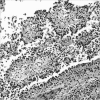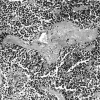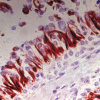Astroblastoma: a case report
- PMID: 15483362
- PMCID: PMC2816349
- DOI: 10.3346/jkms.2004.19.5.772
Astroblastoma: a case report
Abstract
Astroblastoma is one of the very unusual type of tumors, whose histogenesis has not been clarified. It occurs mainly among children or young adults. Astroblastoma is grossly well-demarcated, and shows histologically characteristic perivascular pseudorosettes with frequent vascular hyalinization. Perivascular pseudorosettes in astroblastoma have short and thick cytoplasmic processes and blunt-ended foot plates. A 15-yr-old girl presented with headache and diplopia for one and a half year. A well-demarcated mass, 9.7 cm in diameter, was found in the right frontal lobe in brain MRI, and it was a well-enhanced inhomogenous mass. Cystic changes of various sizes were observed inside the tumor mass as well as in the posterior part of the mass, but no peritumoral edema was found. Histologically, this mass belongs to a typical astroblastoma, and no sign of anaplastic astrocytoma, gemistocytic astrocytoma or glioblastoma was found in any part of the tumor. Immunohistochemically, the tumor cells showed diffuse strong positivity for glial fibrillary acidic protein, S-100 protein, vimentin and neuron specific enolase, and focal positivity for epithelial membrane antigen and CAM 5.2, while showing negativity for synaptophysin, neurofilament protein, pan-cytokeratin and high molecular weight keratin.
Figures






Similar articles
-
A case of cerebral astroblastoma with rhabdoid features: a cytological, histological, and immunohistochemical study.Brain Tumor Pathol. 2016 Jan;33(1):63-70. doi: 10.1007/s10014-015-0241-5. Epub 2015 Nov 27. Brain Tumor Pathol. 2016. PMID: 26614252
-
Astroblastoma presenting with intracerebral hemorrhage misdiagnosed as dural arteriovenous fistula: review of a rare entity.Surg Neurol. 2007 Mar;67(3):308-13. doi: 10.1016/j.surneu.2006.05.050. Epub 2006 Nov 16. Surg Neurol. 2007. PMID: 17320647
-
Astroblastoma with unusual signet-ring-like cell components: a case report and literature review.Neuropathology. 2002 Sep;22(3):200-5. doi: 10.1046/j.1440-1789.2002.00435.x. Neuropathology. 2002. PMID: 12416560
-
[Differential diagnosis of and therapy for anaplastic astroblastoma: case report and review of the literature].No Shinkei Geka. 2013 Oct;41(10):891-9. No Shinkei Geka. 2013. PMID: 24091461 Review. Japanese.
-
Pediatric astroblastoma: a rare case with a review of the literature.Pediatr Neurosurg. 2012;48(2):122-5. doi: 10.1159/000342538. Epub 2012 Oct 4. Pediatr Neurosurg. 2012. PMID: 23038221 Review.
Cited by
-
High-Grade Intraventricular Astroblastoma in a Young Adult: A Rare and Controversial Tumor to Manage.Asian J Neurosurg. 2021 Sep 14;16(3):567-574. doi: 10.4103/ajns.AJNS_430_20. eCollection 2021 Jul-Sep. Asian J Neurosurg. 2021. PMID: 34660370 Free PMC article.
-
Astroblastoma - a rare and challenging tumor: a case report and review of the literature.J Med Case Rep. 2018 Apr 21;12(1):102. doi: 10.1186/s13256-018-1623-1. J Med Case Rep. 2018. PMID: 29678196 Free PMC article. Review.
-
A case report of high-grade astroblastoma in a young adult.CNS Oncol. 2019 Mar;8(1):CNS29. doi: 10.2217/cns-2018-0012. Epub 2019 Feb 28. CNS Oncol. 2019. PMID: 30813777 Free PMC article.
-
Posterior fossa astroblastoma in a child: a case report and a review of the literature.Childs Nerv Syst. 2019 Jul;35(7):1251-1255. doi: 10.1007/s00381-019-04113-3. Epub 2019 Mar 12. Childs Nerv Syst. 2019. PMID: 30859299 Review.
-
High-grade astroblastoma in a child: Report of one case and review of literature.Surg Neurol Int. 2014 Jul 24;5:111. doi: 10.4103/2152-7806.137532. eCollection 2014. Surg Neurol Int. 2014. PMID: 25101206 Free PMC article.
References
-
- Pizer BL, Moss T, Oakhill A, Webb D, Coakham HB. Congenital astroblastoma: an immunohistochemical study. Case report. J Neurosurg. 1995;83:550–555. - PubMed
-
- Lantos PL, Rosenblum MK. Astroblastoma. In: Kleihues P, Cavenee WK, editors. Pathology and genetics of tumors of the nervous system. 2nd ed. Lyon: International Agency for Research on Cancer; 2000. pp. 88–89.
-
- Bailey P, Bucy PC. Astroblastomas of the brain. Acta Psychiatr Neurol. 1930:439–461.
-
- Yamashita J, Handa H, Yamagami T, Haebara H. Astroblastoma of pure type. Surg Neurol. 1985;24:218–222. - PubMed
Publication types
MeSH terms
Substances
LinkOut - more resources
Full Text Sources
Medical

